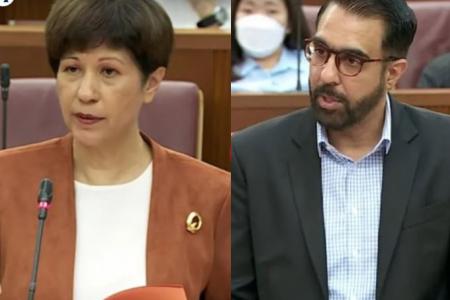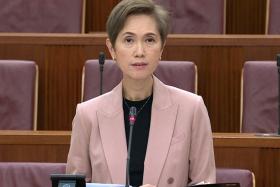Pritam, Indranee spar over HDB development cost breakdown and BTO flat subsidy details
Leader of the Opposition Pritam Singh and Second Minister for Finance and National Development Indranee Rajah on Monday sparred over the development costs of new Housing Board flats and details of subsidies provided to buyers, with the minister saying it was not meaningful to provide such information as affordability is what matters to Singaporeans.
The Workers’ Party chief referenced a recent correction direction issued under the fake news law over HDB’s deficits and Singapore’s past reserves, and asked for a breakdown of the total development cost of all new HDB flats and the dollar value of the subsidies applied to the assessed market price of these new flats.
In response, Ms Indranee told Parliament that development cost is made up of land cost and construction cost. But providing a breakdown of the total development cost of all new Build-To-Order (BTO) flats henceforth is “not helpful or meaningful” for buyers.
“Should we give the total development cost? We don’t think anything would be achieved by doing so. The reason is this – what is the real important thing to Singaporeans? The real important thing is, are you able to afford a flat?” said Ms Indranee, who is also Minister in the Prime Minister’s Office.
Every BTO flat sold by the HDB results in a net loss as the selling price is less than the market price, with different locations having different pricing and subsidies applied to them, she added, noting that it is why BTO flats are so popular among home seekers.
“It’s not meaningful (to give the breakdown) because you will just compare this one with another. Prices in one area may not be the same as the other,” said Ms Indranee.
Replying, Mr Singh (Aljunied GRC) raised the prime location public housing (PLH) model as one reason why a detailed publication of HDB’s subidies is warranted.
Since November 2021, HDB has launched six PLH projects with a subsidy clawback for all set at 6 per cent. This means, owners of these flats will pay 6 per cent of the resale price or valuation, whichever is higher, to HDB when they resell their home on the open market for the first time.
Second, the amount of subsidies used for home-ownership purposes can be scrutinised and tracked if the dollar value of the subsidy is published, he added, especially since BTO prices have been delinked from the HDB resale market since 2011.
Mr Singh said the median price of a four-room and larger resale flat has increased 26 per cent between 2017 and 2022.
“With resale prices reaching record highs today and therefore pushing up the market price of land, increasing the size of the subsidies... would appear to be the main way through which BTO prices can be kept affordable,” he added. “What is preventing HDB from publishing the dollar value of HDB subsidies for new BTO flats?”
Mr Singh also asked why the Government provided only the price to income ratio, mortgage servicing ratio and median price of BTO flats in non-mature estates, and not for mature estates.
In response, Ms Indranee said: “Why would you have to disclose or put out the development costs of every single project? It’s just not meaningful. The key thing is to the buyer, is this affordable and that’s what HDB does.”
On affordability figures for mature estates, she asked Mr Singh to file a separate parliamentary question so that she could give him an accurate answer.
In the first nine months of 2022, the median prices of BTO flats in non-mature estates are $228,000 for three-room flats, $347,000 for four-room flats and $473,000 for five-room flats.
HDB said buyers of these non-mature BTO flats spend 25 per cent or less of their monthly income on their mortgage.
The purchase price is five times the annual household income or less, which is another affordability benchmark that HDB takes into account when pricing flats.
Their exchange comes on the back of growing concerns over housing affordability, with home prices increasing in the last two years.
In its 2021 financial year, HDB incurred a record deficit of $4.367 billion as it disbursed more subsidies and grants to buyers and more BTO projects started construction.
Non-Constituency MP Leong Mun Wai asked if Singaporeans are making “triple payments” for state land that is developed into HDB flats.
The three payments he laid out are: Paying the cost of state land when initially acquired by the Government; the difference between the higher land cost when HDB purchased the land and the amount that the Government initially acquired the land for; and third, through taxes to cover the shortfall incurred by HDB from the land cost paid to past reserves at full market price.
Replying, Ms Indranee said there is no “triple payment” by Singaporeans for the land used to develop HDB flats. The Government does not profit from the sale of state land for public housing either, she added.
When land is acquired for public housing, owners are compensated based on fair market value, since 2007, and this compensation is funded by past reserves or Government revenues, she said.
On why the Government does not simply transfer land to HDB at zero cost, Ms Indranee said if fair market value is not paid in exchange for the land, the past reserves would be depleted with no financial asset to replace the physical asset.
“Requiring HDB to pay fair market value for the land cost thus preserves the value of our past reserves for the benefit of all Singaporeans, both present and future,” she said.
The revenue shortfall that HDB incurs when selling BTO flats at prices lower than market value is covered by a government grant which is funded by returns on Government investments and taxes, which are not only paid by Singaporeans but also permanent residents, foreigners working here, tourists and others, she added.
She also said there is no net increase in past reserves when state land that is sold reverts to the Government upon its lease expiring.
Selling state land simply converts a physical asset to a financial asset for the duration of the lease, and the financial proceeds received are to make up for the state’s loss of the use of the land during that period, she added.
Ms Indranee added that the reserves only increase when the Government invests and grows the financial assets.
“This is the outcome of careful and prudent management of our reserves by this Government and should not be taken for granted,” she said.
Get The New Paper on your phone with the free TNP app. Download from the Apple App Store or Google Play Store now


